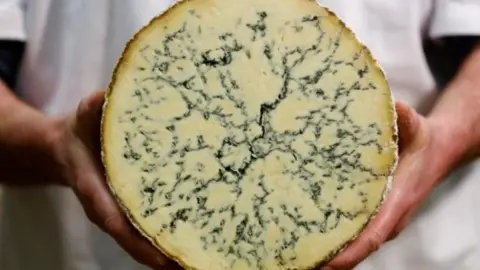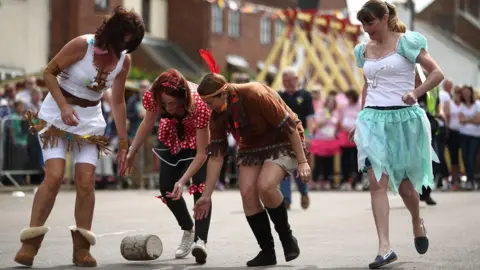Why can't Stilton make Stilton?
 Getty Images
Getty ImagesThe famous blue cheese it gave its name to is known throughout the world, but despite years of local protests, the Cambridgeshire village of Stilton is still not allowed to produce it.
The history of Stilton is more controversial than you might think. A battle over what the name can and can't be applied to has been rumbling for years.
So, as a former MP raises the subject again, what's in a name and what could the future hold for this fought-over foodstuff?
How did Stilton cheese get its name?
 Getty Images
Getty ImagesIt was thought that the famous cheese was named after the village of Stilton, just south of Peterborough, not because it was made there, but because it was sold at The Bell Inn there.
However, some historians have claimed the cheese did, in fact, originate in the village in the 18th Century.
In 2011, Stilton resident and local historian Richard Landy claimed to have documents that could potentially prove the cheese was first produced there.
Mr Landy told the BBC at the time: "I stumbled across a reference to a recipe on the internet that had been sent to Richard Bradley, the first professor of botany at Cambridge University.
"This recipe was not only earlier than any previous recipe that had been published, but it also says that the cheese was produced in the village of Stilton."
The conversation continues to this day, with residents and a former MP calling for a change in the law to allow the cheese to be made in the village.
What rules prevent it from being made in Stilton?
 Getty Images
Getty ImagesA row about the origins of Stilton and who can make it has been rumbling for years.
The Stilton Cheesemakers' Association achieved Protected Designation of Origin (PDO) status for blue Stilton from the European Commission in 1996.
This meant that only cheese produced in three counties - Derbyshire, Leicestershire and Nottinghamshire - could be called Stilton.
Despite Brexit, the legal protection continues.
Stilton is one of just a few products that enjoy this status. Many English regional cheeses, such as Lancashire, Red Leicester and Double Gloucester, are not protected.
What other foods have protected status?
 Getty Images
Getty ImagesWhile Stilton continues to have special protection, it is not the only British food or drink product to enjoy this.
Scotch Whisky, for example, can only be produced, unsurprisingly, in Scotland, and even within that there are tightly controlled regions.
For instance, Campbeltown whiskies can only come from a specific part of the Kintyre peninsula, while Islay whiskies must be from the island of the same name.
And although you can find a pastry-encrusted snack of meat, potato and vegetables almost anywhere these days, a true Cornish Pasty must originate from Cornwall.
The same applies to another famous meat and pastry product. If your pork pie is not from the Leicestershire town, it cannot be called a Melton Mowbray.
Similarly, if your oyster does not come from Pembrokeshire, then it does not qualify as a Pembrokeshire Rock Oyster.
What is the Stilton Cheese Rolling Festival?
 Getty Images
Getty ImagesThe annual cheese-rolling event in the Cambridgeshire village dates back to the 1950s.
The tradition was started by four publicans who were thinking of ways to generate income after Stilton was bypassed by the A1 in 1959, Adam Leon, one of its organisers previously told the BBC.
The event was paused for seven years because organisers said it was no longer seen as "cool", but it returned in 2024.
You would be forgiven for thinking a cheese-rolling festival would involve the dairy product itself.
However, 12in (30cm) sections of an old telegraph pole are painted to look like a cheese.
To participate, all teams must consist of four members, and the "cheeses" must be rolled by hand.
Each team member has to roll the cheese at least once during the race, which takes place on on a course of about 30m (100ft) in length.
Typically, people have taken part wearing fancy dress, and in the past teams of nuns, Smurfs and even a tribute to rock band Kiss have participated.
Could Stilton ever make Stilton once again?
 Shariqua Ahmed/BBC
Shariqua Ahmed/BBCFormer Conservative MP for North West Cambridgeshire, Shailesh Vara, is one of the people who have been voicing their opinions on the cheese's origins.
Mr Vara, who lost his seat to Labour's Sam Carling in July 2024, said: "Stilton cheese was historically made in the village, and I know there has been a bit of dispute about that.
"But the historical evidence that I have seen in the case that the cheese was made here."
He added that Mr Leon, described by Mr Vara as a "local entrepreneur", had started "making efforts to make sure that we start making cheese locally again".
He said: "I am in conversation with Adam and the villagers have my support, and whatever conversations they want to have with me, I am always available."
According to Mr Vara, now the UK has left the European Union there is less protection on where Stilton can be produced.
"That protection is no more, so we can now start making cheese. I am looking for it to be made again," he added.
The UK Protected Food Names Association, however, maintains that English law protects Stilton, and that any change would undermine the cheese-making industry.
Follow Cambridgeshire news on BBC Sounds, Facebook, Instagram and X.
